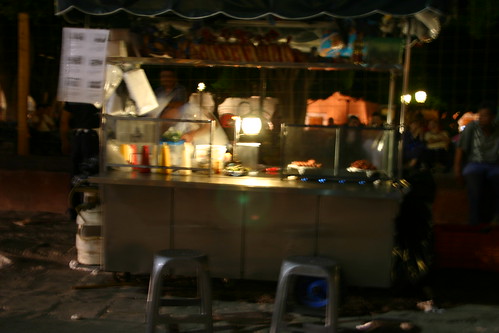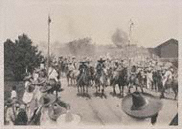
July 21, 2005
July 18, 2005
"Power, Faith, Image": 16th-19th Century Philippine Art in Ivory:" Phillipines, Mexico, European Connections

1600-1800's: Nativity Scene, 18th century
Ecuadoran, with Hispano-Philippine ivory inserts
Bodies of wood, polychromed and gilded; faces and shoulders, ivory touched up with polychromy; (.172): H. 7 3/4 in. (19.7 cm); (.173): H. 8 1/2 in. (21.6 cm); (.174): L. 2 3/4 in. (7 cm)
"Power + Faith + Image: 16th-19th Century Philippine Art in Ivory" is one of the inaugural exhibits at the new Ayala Museum.
To mark the milestone exhibit, the museum organized an international symposium, "Manila, World Entrepot," on July 8-10 in which foreign and Filipino scholars read papers on the Philippine ivory trade and 19th-century Philippine watercolor images.
The Ayala Foundation published "Power Faith Image" (2004), co-authored by Regalado Trota Josè and Ramòn Villegas, a superb publication documenting the exhibition and tracing religious sculpture in ivory as an art form where the Philippines excelled globally during the Spanish colonial period.
The exhibit, curated by Josè and Villegas, is an exceptional exhibition which gathers the largest, most significant assemblage of mostly privately owned ivories, never exhibited in public. On view are 400 examples of rare Philippine ivory sculptures that establish beyond doubt the prominence of Philippine ivory sculpture in world art history.
The exhibition presents a sumptuous overview of the virtually unappreciated excellence of Philippine creativity that, while unknown to many today, of world-renowned during the Spanish colonial era.
"The Philippine ivory tradition surpassed that of any other country for its range, scope and sheer volume," write the authors. Since 1590, artisans in the Chinese district of Manila carved Christian images in ivory, prized and venerated in palaces, cathedrals, churches and monasteries in Europe and the Americas.
Christian imagery carved by Philippine craftsmen blended Oriental features along Western models. A characteristic is the expression of meditative calm in the Buddhist tradition that ranges "from an inscrutable stare to an incipient smile" articulated in all carved Philippine santos.
Eventually Philippine stylistic elements made their way into Indo-Portuguese ivories carved in Sri Lanka and India. Studies prove that "the Philippine Madonna and Child became the model for the Kuan-yin," the Chinese deity of mercy, and not the other way around as previously thought.
Evolution of forms
Basic forms evolved in ivory carving. A complete figure, whether completely of ivory or of ivory parts (usually head and hands) mounted on a fully carved wooden body, were called de bulto (origin of rebulto, Filipino for "statue").
Statues with ivory head and hands attached to an open conical framework to be covered with a dress were called de bastidor.
Some wooden statues had ivory faces that in reality were frontal masks fitted into wooden heads.
Religious scenes, called reliefs, carved into flat pieces of wood were often fitted with ivory details. Elaborate miniature tableaux of religious scenes sometimes combining ivory with glass, gold and precious stones were kept under virinas (glass covers).
Ivory was a precious object of prestige and luxury, often shown off by occupying the place of honor in a church or private home, dressed in lavishly embroidered silks and often embellished with gold, silver and precious stones.
The glory days of ivory, the exhibition implies, are of the past.
Ivory statues, now rarely seen in churches, have mostly been destroyed, vandalized or stolen. The best examples are in private collections, away from public view.
Ivory is not for the everyday. It is a ritual object. The ultimate moment of an ivory santo is when it is borne in procession. "Only when dressed in gorgeous robes... can Ivory images be seen in their best context: They are borne by believers on paths of Power, Faith and Art."
The international ivory trade was among the primary topics during the conference, which focused on linkages resulting from the exchange of objects and influences between the Philippines, Asia, Europe and the Americas during the Spanish colonial era.
Globalization
Papers read by Benito Legarda and Fernando Zialcita affirm that the galleon trade starting in 1565 that continued for most of the Spanish regime was the world's longest-running international trade route, opening a process of globalization.
Once a year, galleons plied the Manila-Acapulco route carrying products not only from the Philippines but also from all over Asia. Goods were exchanged, and so were cultural influences.
Because of the galleon trade, Zialcita said, two cultural waves met in Manila. One began in the Mediterranean, crossed the Indian subcontinent and Southeast Asia to the Philippines. Another wave began on the Atlantic coast of Europe, swept the opposite direction through the Americas and the Pacific toward the Philippines.
Both waves ended in the Philippines where they met other cultures, the Philippine, Chinese and the Japanese, making the Philippines "the only true end-point in the world," as Zialcita quotes French historian Pierre Chaunu.
Diverse cultures fused at the "end point" of the world. Manila festivals were so cosmopolitan that in 1611 entries to a poetry contest were submitted in Latin, Greek, Italian, Portuguese, Basque, Castillian, Mexican, Tagalog and Visayan.
Philippine culture traveled to other parts of the world as well. Mangoes crossed the ocean to Mexico, where the fruit is still called mango de Manila. Vegetables cooked in coconut are called guinatan on the west coast of Mexico.
Philippine export items of prestige, however, were definitely the ivory figures venerated and honored in churches, monasteries and homes in the New World and in Spain, objects that are just beginning to capture the attention of international scholars who recognize them an important international development from the Philippines, significant in the East-West fusion of art traditions.
"Human achievements also matter," writes Zialcita.
The exhibition, publication and international conference prove that religious ivory is a human achievement of the Philippines that does matter. They are proof of Philippine excellence.
E-mail feedback to afvillalon@hotmail.com
Retratos, 2,000 years of Latin American Art

Latin America has a long and rich tradition of portraiture. For more than two thousand years, portraits have been used to preserve the memory of the deceased, provide continuity between the living and the dead, bolster the social standing of the aristocracy, mark the deeds of the mighty, record rites of passage, and, in modern times, mock the symbols of the status quo. Portraits connect the individual to the family, the family to the community, and the community to the nation. They bind together disparate populations and help establish national identity. Portraiture is an art form with which most of us identify and is an expression that provides us valuable insight into the lives and minds of the artist and sitter, as well as their time and place.
Interesting web site from the exhibition sponsored by the Ford Motor Company, curated by Marion Oettinger, Jr., interim director and curator of Latin American art at the San Antonio Museum of Art; Fatima Bercht, chief curator at El Museo del Barrio; Carolyn Carr, deputy director and chief curator at the Smithsonian Institution’s National Portrait Gallery; and Miguel Bretos, a historian with expertise in Latin America and senior scholar with the National Portrait Gallery
July 12, 2005
Getty Collection:Mexico, From Empire to Revolution

Excellent site with the history, and chronology of Mexico's transistion.
...Mexico: From Empire to Revolution covers approximately sixty years. It begins in 1857 with the appointment of Benito Juárez as acting President of the Republic and the arrival of the French photographer Désiré Charnay from France. It ends with the final phases of the Revolution, the election of Álvaro Obregón as President in 1920 and the photographs of 1923 that record the bloody assassination of one of the leaders of the Revolution, Pancho Villa. This period represents one of the most dramatic and violent in Mexico’s history. In that short span of time the country experienced imperial intervention followed by conflict, rebellion and finally revolution.
There are, in a sense, two histories here, a history of Mexico and another of photography: two histories that interact and reflect upon one another. The photographs taken had a powerful influence over the course of events. Many represent photo opportunities for leaders, groups and movements to publicize themselves and their cause. Other images expose harsh realities of brutality and violence that for some are best forgotten, These images provide evidence of what had disappeared or would be otherwise lost in the folds and shadows of a larger history of a nation and countries at war....except from site.
Mexican Photography Archives
http://www.universes-in-universe.de/america/mex/photography links, excellent for research.
Postcards Of Luis Marquez, Mexican folklore and history in 20th Century Art Postcards
Great sites that explores the history of Mexican postcards, photography written by Susan Toomey Frost.
Photographer: Pablo Ortiz Monasterio
Photographer: Graciela Iturbide

Graciela finds the theatical in the ordinary, the death in the life, the history in the now. In her hands, a camera is "an instrument capable of disintigrating moral barriers, personal and social inhibitions, trusts and distrusts." A headdress of iguanas, a bull-headed bicycle, a skull mask at First Communion...Graciela conjures the dream-like from the day-to-day.
Subscribe to:
Posts (Atom)



